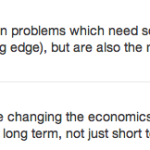
Today, Scott Olson published an editorial at TCPalm, a local news site for Palm Beach area on some very deep misgivings that all of us in deep-sea biologist have regarding the state of Harbor Branch Oceanographic Institute and its assets – the Johnson Sea Link submersibles. It was a poignant and accurate assessment from the heart of a man who spent 14 years as part of the submersible and robotics team. This hits particularly heavy given the closing down of the Space Shuttle program, but an equally disastrous yet barely sung development is that at the end of the month all remaining submersible personnel will be laid off permanently.
40 years, 9000 dives and 2 submersibles thrown down the drain. Regardless if you are from MBARI, WHOI, University of Washington or any other submersible research competitor there is no doubt that this long and prestigious career should not have passed away so unceremoniously. The Sea Links have been featured in numerous documentaries on National Geographic, Discover, PBS, local stations around the Gulf and Atlantic. Innumerable discoveries in the deep-sea have made using thee versatile machines and highly-skilled crew.
I had the pleasure of going down and using them in research at Gulf Mexico seeps between 500-700 meters depth where I witnessed first hand in a wide frame (thanks to the acrylic sphere) the magnitude of the huge expanse of giant tubeworm gardens. But my history with these machines is but a mere speck on the illustrious careers they have inspired and started. It was just over 2 years ago, in May 2009, that I wrote about my dismay with falling apart of HBOI and their vessels and subs. This set off a storm of posts and comments here on Deep Sea News with much support from the community.
More recently, the Sea Link was pivotal in helping researchers access the deep-sea to understand effects the Deepwater Horizon oil spill might have on the important coral communities, in addition to giving journalists a first hand look at the disaster so that they could relay this to the public. (Over 10,000 hits exist for “Johnson Sea Link” + “oil spill”.) What a disservice we are doing to our country by not maintaining a fleet of deep submergence vehicles close to our borders which can rapidly respond to crises such as oil spills! With so few manned submersibles operating out of the USA, and each being used for research purposes all over the world, we kicked the proverbial pony on ourselves here.
The subs and the vessels and the HBOI are clearly needed for advancement in ocean sciences, but Scott hits on a very real point:
The reasons for the demise of such a successful program are convoluted, but in my opinion they all point back to a lack of visionary leadership at multiple levels, including at the institute and in state and federal governments. In my opinion, the endowment bequeathed to the institute upon the deaths of its co-founders in the 1980s was severely mismanaged and the subsequent FAU managers did not appreciate the value of the program.
Most of the blame, however, lies with the shortsightedness of the U.S. public and the counterproductive infighting at the program-bloated sources of federal funding; the National Oceanic and Atmospheric Administration and the National Science Foundation.
There is plenty of blame to go around. But if we dumping millions of dollars of oceanographic equipment in foreign lands and shutting down an American icon such as the space shuttle program, what are our priorities? A commenter on Olson’s article, who goes by clearstory, suggests:
“The US is walking away from more than technical and scientific leadership . It’s getting to the point we don’t manufacture anything other than weapons.”
Politics will always be a barrier to progress, but when we lose our icons of exploration and research – the ship, the sub, the shuttle – what will symbolize the pride we feel in American innovation and scientific leadership? As Olson says, some of the blame lies in the shortsightedness of the US public. But how they appreciate what they don’t know exists.
Lets look to ourselves, the marine science community, to place some of that blame on. We have failed to capture the American imagination of at-sea exploration, discovery and scientific research. We tried to do this with the “WOW” factor: new species! WOW! big squids! WOW! strange fish! WOW! But I think people want more than that. They want to know why we are down there, what we hope to accomplish and how this affects them. We’ve underestimated the intelligence of that unknown quantity we called “the public” and I think, frankly, they are bored.
Hell, I’m bored. I was bored with my research in grad school cause it wasn’t relevant to people. My advisor asked me to prepare a response for “why should the American public fund you research?” Every time I caught myself saying bullshit statements like: to advance basic understanding of… *yawn*, because we need to understand species distributions because …. *yawn*, we’ve found so many important and potentially life-saving medical compounds from deep-sea animals…. well, ok that one is pretty damn useful but not at all what I do. Why should the “average American”, i.e. my parents, fund my work? They shouldn’t. Unless finding new things and going new places excites them.
NASA has done a pretty solid job of capitalizing on the human spirit, American patriotism and sense of awe and pride in the past with manned space exploration, astronauts and the shuttles. Marine science on the other hand, has not. How often are marine biologists on The Today Show, for instance. Does the public appreciate the dedication and training of oceanographers, sub and ship crew in the same way as astronauts, mission control and NASA engineers? I don’t think so. And now, we silently have blood on our hands. Not the first ax to fall, but a heavy one.
The solution is simple. Give a damn. Give a damn like you never gave a damn in your life! Show off you passion for the ocean at every available opportunity. Make it a lifestyle choice. Make as much noise for the ocean as you can! SHOW people what you do.
YOUR SCIENCE IS NOTHING WITHOUT THE SUPPORT OF PEOPLE.
Never forget it either. At the end of Seuss’ The Lorax, the Onceler comes to the realization, “Unless someone like you cares a whole awful lot, nothing is going to get better. It’s not.” If marine scientists don’t seem care, or at the very least appear to care, why should anyone else? I know we care! So lets show it to everyone! Write your local papers, indy mags, popular science mags. Tell you press officers everything you do. Make a big deal for the ocean! We can’t afford to throw away any more tools.






To repeat an old Norse probverb, “bundinn er bátlaus maður.” Bound is boatless man…
I guess the trick is to let people see what it’s like to be unbound, as it were…
Good point on politics. We never had a “race to the Mariana Trench” against the USSR. That’s probably one big reason why deep-sea exploration hasn’t gotten the same support.
No. 2? Hollywood. We’ve had the long-ago deep-sea science fiction of 20,000 Leagues Under the Sea, the bomb that was Waterworld and nothing else. Meanwhile, Apollo 13 and The Right Stuff both captivated viewers.
I’m an artist (fashion handbags and sculpture) and I care what ya’ll do. It’s exciting to me and is part of many of my works. When I do make it as a rich and famous artist my plan is to have my own luxury submarine from U.S. Subs and I will be taking 4th graders, Marine Biologists, wealthy patrons and a whole ranging cross section of the public beneath the waves to show them how amazing and how much is below the surface. I need researchers like all of you to continue to have a passion for what you do. I will give you the vehicle to continue and to educate all of us. There will be no regulations to stop a private individual that wants to see this research continue. Hold on, it will happen, I promise.
on a somewhat related topic, and speaking on Olsons, I think the recent article by Randy Olson on The Benshi about the CDC coming up with creative ways (zombies!) to engage the public on important public health topics is poignant. Perhaps the marine science community also needs to get creative…
http://thebenshi.com/2011/07/20/143-cdc-2-anatomy-of-a-public-relations-massive-success-zombie-preparedness/
Thank you for writing this. Having worked at HBOI as an engineer for 20 years before being let go last month, I saw the slow decline of the submersible operations first hand. Essentially, the decline started with the separation from the Johnson family. Without their continued funding, we were left with millions in shortfalls every year. However, the decline was accelerated once we became part of FAU. As Scott mentioned, the lack of leadership, especially in the last 3 to 4 years, led to the sale of the final ship at very little profit, if any. With that sale, the execution notice for the submersibles was signed. The union with FAU brought HBOI a $48 million one time grant and approximately $8 million a year in recurring funding from the State of Florida. How no one could come up with a creative solution for using part of those funds to keep the ship and sub operating is beyond me. Instead a science building was put up less than 5 years after one was built by FAU pre merger which has yet to be filled to occupancy.
As for why the scientific community has never been able to garner the WOW factor from the public is something that has been discussed for many years. Currently, we don’t have any major celebrities that have captured the public’s attention. Cousteau was the closest we’ve ever come to a Neil Armstrong or John Glenn. Ballard was right up there when Titanic was investigated, but is seldom mentioned in the news anymore.
If the US is not concerned that it has no means of transporting its own people into space, then there is little hope anyone will care if one of its vehicles taking people down into the depths of the ocean is lost.
I agree about Hollywood. Even marine “science” films have to be “spacified” (i.e. the Abyss) or rely of scare (i.e. Jaws, Deep Blue Sea).
I think we need to somehow involve pride and patriotism in marine research. Sounds silly, but uniforms go a long away. Think about NASA and the astronaut. The mission badges, the US flag, these are things that are collectable, make the astronaut look almost regal and give a strong sense of team pride. We are all in this together to get that gigantic piece of metal into outer space! Every expedition leaving port for a month-long trip out to sea should be met with the same sense of awe and wonder.
Ha! We should definitely stay in touch! And thanks very reading and commenting. You’re metal working is fantastic!
Avatar 2 will have some undersea elements… and don’t overlook Sharktopus. ;)
My two youngest kids still ask to see NatGeo’s “Sea Monsters” from time to time.
Thanks for writing this, Kevin. I agree this is a sad story, especially given that DSV Alvin is in semi-retirement and the shuttle program is finished. I wouldn’t say all that work is down the drain, though. Let’s not overlook the volumes of science that are still forthcoming from those expeditions. Further, its a credit to the JSL engineers and to HBOI that one JSL continues to be useful for the country of Brazil. We continue to export American ingenuity, and that’s a good thing.
While I agree with Ladd that celebrities are part of the solution, my feeling is that the precedents speak otherwise. Sylvia Earle is doing a terrific job inspiring people, but HBOI’s glory days came under J&J and MBARI’s excellence continues thanks to Packard Family. So, ocean science probably owes more to the generosity and fascination of industry than it does to movie stars. Just my two cents.
I agree to some extent, but marine sciences need better reach. People are interested in other people so they are inclined to visit CDC. But are they as inclined to visit NOAA? I doubt NOAA would have the flexibility to do something like this. Their site is also horribly outdated too. Its a cleaner interface and better navigation.
The JSL that has been left in Brazil will be brought back to the US and like the shuttles, will become just a display piece.
Hi Kevin,
Interesting post and reading Scott Olson’s text and comments really surprised me. I never fully understood why an US Oceanographic Institution would sell the Seward Johnson or the JSL, especially when its being used (or getting dusted in a garage in the case of the submersible) below its full research capacity. Unfortunately, this lack of visionary leadership is also seen around here, as the ship is being exclusively used by an oil company, with no access to carry independent research by brazilian scientists. I feel this is even more unfortunate as we lack any means (ROV, Submersibles and video) of studying our deep continental margin.
All the best,
angelo.
Thats too, but how many people can afford the fancy cable or satellite to get NatGeo Channel? I can’t even. Just basic cheapo tv for me. But it is very important to reach more than one audience so definitely inherent value in these programs.
I think this is a very good point.
Very nicely put, Kevin. I think one of the main reasons that these and other assets are disappearing is that the priorities for ocean exploration have shifted. Many of the folks making the decisions are set on the idea that we can use ROVs, AUVs, and even more abstractly ocean observatories and (soon) telepresence technology to see the ocean depths. They fail to see the value in putting an actual scientist (or reporter or filmaker) on the bottom of the ocean. In my opinion, the idea that you get the same sense of the habitat, and can convey the same sense of excitement about your research by seeing it from the inside of a control van or from your desk in your office, is simply false. I will never forget being inches away from a black smoker, or flying over a football field of tubeworms in the Gulf. The new generation of remotely operated vehicles are fantastic tools for research, but will never allow scientists to convey their sense of wonder and capture the public imagination the same way.
As for the space race analogy, there is one underway right now between the new Alvin and the new Chinese submersible. Not sure it will inspire quite the same level of public support, but it would help if more people were aware of it… Hopefully the unveiling of the new Alvin next year will help this cause.
I am not a marine biologist. I am a married father of seven, maintain a hobby farm, and am part owner in a family business. I live three hours inland of the Atlantic. Nevertheless, the “sea’s in my veins”, as Buffett succinctly sang.
I have always been fascinated by liquid space. These days, that passion appears in the form of my undersea Dungeons & Dragons game (I’ve been running undersea games since 1998), my saltwater aquariums, my weedy seadragon tattoo, and swimming as a merman in Second Life. The closest I get to saltwater is when I top off the water softener for well water, dump salt in the pool for the saltwater chlorinator, or mix up a few hundred gallons of Instant Ocean for my tanks. I frequent this site and others like it, stay glued to NatGeo and Discovery on TV, and enjoy vacation time at Topsail Beach for a week each summer. If I had a do-over, I would have studied marine biology, but I had an older brother enter that field and no little brother wants to do what his big brother does.
If tomorrow I won the lottery, one item on my shopping list would be a seastead situated over a remote seamount far out at sea. Living “away from the things of man”; deriving power from the sun, wind, and waves, drinking fresh water pulled from the humid air or cleansed from RO/DI filters, and feasting on the bounty of the sea farmed in AquaPods. I would have hydroponic gardens, a flock of chickens (meat, eggs) and herd of goats (meat, milk), and harvest biofuel from algae. I would study the creation of new reef structures aided by low-voltage (electric reefs) or perhaps derive a new delicacy from dream fish (sarpa salpa that consume caulerpa taxifolia).
In the meantime, I look forward to the exhibition of Titanic artifacts soon to be on display at my local Natural Science Center next week and of course Shark Week (the UStream video feed from the Atlanta Aquarium is frequently visited, these days). And perhaps on my next birthday I’ll get that tattoo of Aurora the octopus.
You say “I know we care! So let’s show it to everyone!” Caring isn’t enough; showing it to everyone helps … only if you CONNECT with the people you are trying to share with. I just finished a great book on communication: “Made to Stick, why some ideas survive and others don’t.” There’s a very apropo story on page 199-200 about people who were very passionate about their cause but needed to fundamentally change their message to connect with people. This easy to read book can help you make your message connect. I am a scientist and invest in bringing science into the schools and into the public eye in my own ways. I am also Scott Olson’s uncle and am part of this conversation only becuase of that relationship. Good luck on elevating deep sea science in the public view.
Thanks for dropping by and the book recommendation! I am a firm believer in communication pluralism, using different approaches to reach out to as many audiences as possible. I think part of the problem is as scientists, we are often poor judges of who are audiences are. Making it very hard t o make that connection. Anecdotally, I think I’ve had more rewarding success discussing science with random strangers at a bar (before they even know I’m a scientist) than any other initiative. I think maybe I need to start a “drunken science” initiative that gets scientists into bars and strike up conversations with locals without making a big deal they are scientists… ;)
Kevin
Great piece and sad news for sure. A sure sign of a lack of visionary leadership and effective investment in productive and meaningful ocean science. I agree with much of what has been written by you and the comments, and have been fighting the fight to engage the public….but there are many obstacles. Not the least of which is that it is very undervalued in the ocean science community and for someone like me, trying to do it for the community as a whole, not a particular institution or research project, funding can be hard to come by.
Yes, we need to get the public behind ocean science, by making it engaging, relevant to the average person, and understandable. This is exactly what I am trying to do in my new book, Sex, Drugs, and Sea Slime: The Oceans’ Oddest Creatures and Why They Matter. I have had a terrific response from readers and at talks, great media attention from NPR radio and its affiliates, and fantastic reviews. However, even though I have an excellent track record going on air as an expert and contacts with the television media, I cannot get them engaged. And unfortunately, this is where most people still get their information (though the internet is catching up fast). It has been very frustrating – the humor and relevance in the book is perfect for talk shows, morning television etc. We seem to only catch there attention when their is a related disaster or crises. I have also discovered that the science community does not quite get how to reach out to the public and use it to their advantage, especially for potential fundraising.
We have a lot to learn about how to engage the public (I am still learning), work with the media and entertainment industry, raise funds from non-traditional sources, and cultivate the leadership we need in Washington and even at our own universities.
Lets hope the tide will turn soon!
Ellen, thanks very much for stopping by and commenting. You honest assessment and self-reflection is valuable. Like you, I am trying to seek funding to do whatever I can to raise ocean awareness. Perhaps a group of us need to band together and form a lobbying group for media (not just policy makers) to get out the word more!
I’d like to point out that James Cameron has done an excellent job promoting manned exploration of the oceans. His movie “The Abyss”, which rated pretty darn high in underwater coolness,introduced millions to the possiblities. How about the submersible dives featured in his block buster “Titanic”? Then, as if that wasn’t enough, the man spent his own money and designed his own sub and explored the bottom of the worlds deepest ocean trench himself!
Not everyone can be James Cameron, but it would be great if more of us could display his kind of passion for ocean exploration.